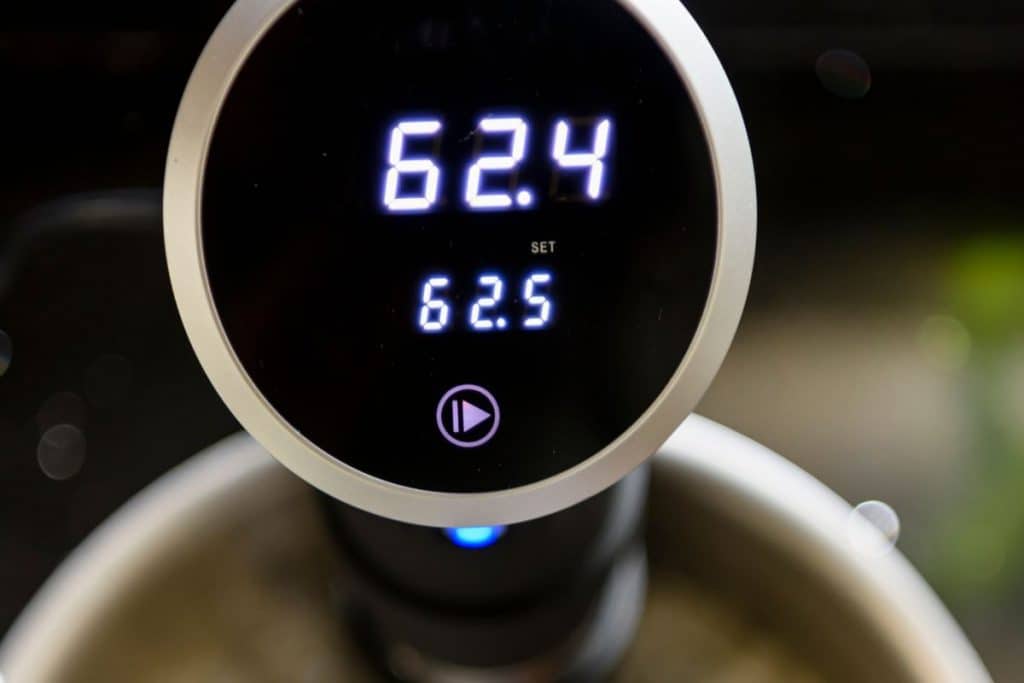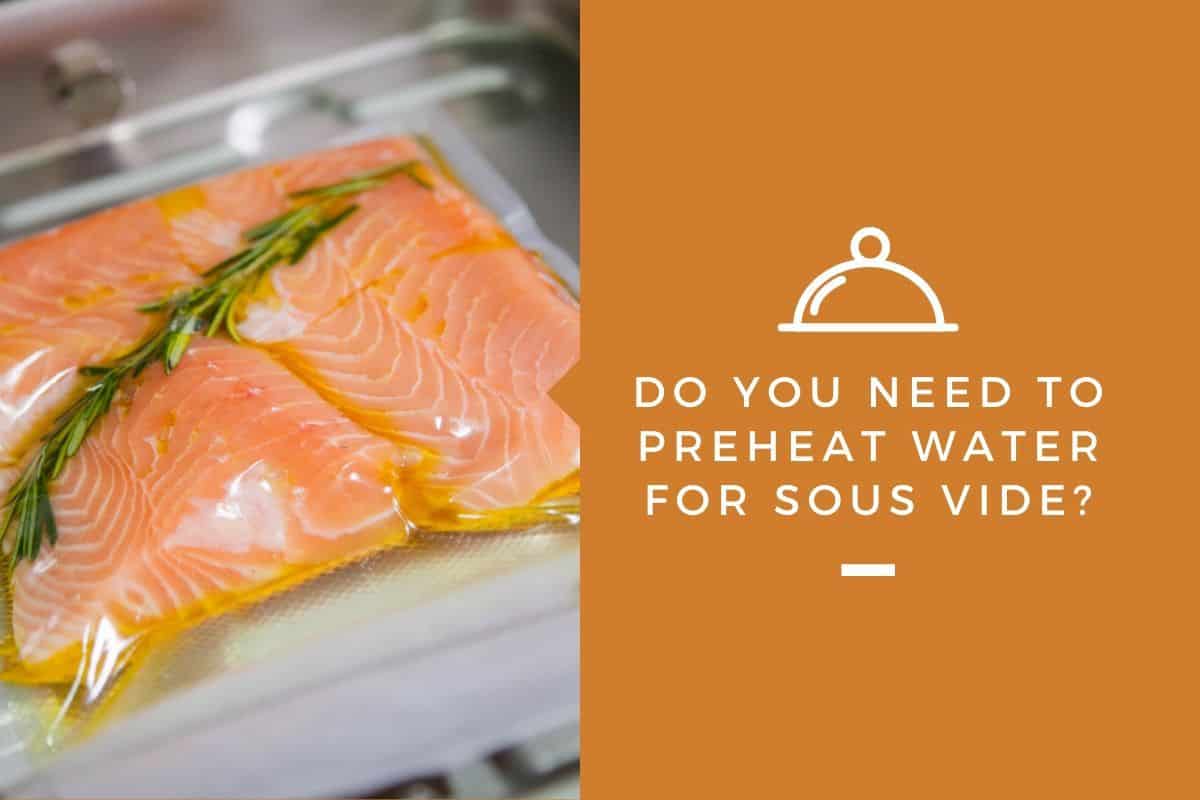Sous vide has become a popular method of cooking to help reduce the risk of under or overcooking. Questions surrounding water temperature and preheating are common, as this low temperature, the long-time method has continued to gain popularity.
Do you need to preheat water for Sous Vide?
Preheating your water before you add food is a good idea because it reduces temperature fluctuations. The water needs to reach the appropriate temperature for the recipe before placing food in it. You can use a pot or a water bath for preheating, and you’ll need a food thermometer to monitor the temperature.
The fantastic thing about Sous Vide is the simplicity of the process that doesn’t vary significantly between different recipes and types of food. You will still follow many of the same steps, including how to go about preheating your water.
How do you Preheat a Sous Vide?
Sous Vide focuses on precision. At the heart of this cooking method lies a reliable way to regulate temperatures and cook your food perfectly every time.
This doesn’t mean there are no directions to follow, but you can rest assured that this is an easy process designed for consistency.
If you have a Precision Cooker or Sous Vide Stick, you will be able to preheat and regulate temperatures directly through the appliance. We’ll talk more specifically about the heating up process for those in the next section.
If you don’t have the additional appliances, don’t worry. You can easily use the Sous Vide cooking methods without them.
Here are some simple steps to follow:
- Fill your pot or water bath with water, leaving enough room at the top so that when you add the food, it does not overflow.
- Place a thermometer on the side of the pot by mounting it so that it stays submerged, or at least have it handy to begin monitoring temperatures as you go. If your thermometer doesn’t have a mounting feature, you can also use a heavy-duty metallic clamp. Just be sure to use oven mitts when removing it.
- Turn your burners up to medium-low and wait for the water to reach the desired cooking temperature that is listed in the recipe you’re using.
You want the temperature to gain steadily. Therefore, it is crucial to have the water warm slowly over medium-low heat, rather than a high heat that will work faster but not as steady. You may find you need to adjust the burner if you notice the temperature lacks a consistent climb.
Don’t stress if you can’t seem to get a steady increase right away! It can take some time to ensure the temperatures are climbing as they should. Stirring the water occasionally can also help, as it moves the water around so that everything is getting even heat distribution.
Once your water reaches the optimal temperature for your recipe, you can add the food. You’ll want to have it already seasoned and ready to go in your bag so that once the temperature is reached, you can place the food immediately after.
Pro Tip: If you are using a standard pot and need to find a way to let air escape the bag, you can use a clip or clothespin to attach the opening of the bag to the side of the pot. This will allow the air to escape the same way a professional appliance would allow.
How Long Does a Sous Vide Stick Take to Preheat?

If you decide this is a cooking method, you’ll be using a lot. It may be worth looking into purchasing a Sous Vide Stick. These metallic gadgets that appear to be from the future will help you maintain a steady environment for your food through the entire preheating and cooking process.
Most Sous Vide Sticks will take around 15 minutes to heat properly when starting with room temperature tap water. But there are a few variables that can change that number.
The variances that come with preheating will have to do with the starting temperature of the water. If you draw hot water from the tap or use filtered water from the fridge – your overall preheating times will fluctuate.
You should consider the amount of water you need to heat. The bigger the pot, the longer it will take.
These cookers offer a great way to maintain the steady conditions needed for Sous Vide, and many even come with Bluetooth options so you can control and monitor directly from your phone.
Pro Tip: Go heavy on the water. Make sure it will not overflow once you add the food but use as much as you can. It will take a little longer to preheat but will help regulate the water when the food is added.
If the food is cold, fresh out of the fridge, it will naturally drop the water temperature a bit once it is added.
The more water there is, the less it will affect it. Therefore, it should help keep it better regulated. You can also consider bringing the food out of the fridge for 10-15 minutes to help increase the temperature a little, so the change in the water will be less severe.
Can you Put Meat in While the Sous Vide is Preheating?
While it is possible to do this and still achieve a fully cooked dish, it isn’t optimal for cooking. The consistent method of Sous Vide relies on the elements to be steady and even.
If you put the meat into the water while it is room temperature, it will be going through all the temperature changes as it preheats.
This will cause an inconsistency in the recipe and will not do you any favors with the flavor. Some may think it is a time-saving method because the meat can start cooking a little sooner as the water heats up.
But Sous Vide isn’t a method that is meant for a quick meal that you want to throw together in 10 minutes. It is similar in ideology to a slow cooker to stews or BBQ. The flavor needs time to marinate within the bag, and the timing of everything in this process is key to making it as flavorful and tender as possible.
The preheating process becomes even more critical when dealing with food that requires a shorter period of cooking time. Think of it as a percentage of the whole cooking time.
If your dish will take 1-2 hours to cook, but the first 15-20 minutes is spent with fluctuating temperatures, it will not garner the delicious result you were hoping for.
If it takes 5 hours to cook, those first 15 or 20 minutes might not have as much as on impact on the result because it has a longer recovery time where it will be able to be in steadily heated water.
While it may affect it less, it is still wise to preheat no matter the length of your cooking time.
Using Sous Vide to Make Your Best Meals
Whether you are whipping up a perfectly cooked steak, some asparagus with a nice snap, or some fish that you want flaky and flavorful, Sous Vide is an excellent method to master.
Preheating the water thoroughly before adding any food is always going to be a best practice that should be followed for the best results.
Make sure you have all the supplies you need, allow yourself enough time for proper preheating, and do everything you can to maintain and regulate steady temperatures.

